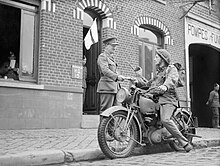Beaumanor Hall

Beaumanor Hall is a mansion in the central English county of Leicestershire, surrounded by a large park . It is in the small village of Woodhouse on the edge of the Charnwood forest near the town of Loughborough . During the Second World War , it housed an important listening point for the British secret service . It has now become municipal ownership of Leicestershire County Council and is used as a convention center for meetings, seminars and also as a youth hostel. It is a listed building and can be visited. Guided tours are offered from time to time.
Early history
After the Norman conquest of England in 1066, the lands first belonged to Hugh d'Avranches, 1st Earl of Chester , († 1101), before they passed to Henry de Beaumont († 1340) in 1327 . He had a new building erected there in 1330 and named it Beau Manor , alluding to his own name , which (with French beau for “beautiful”) also means “beautiful house ”. Sir William Herrick (1562-1653), English member of the House of Commons under Queen Elizabeth I (1533-1603), replaced it in 1595 with a new building that lasted until 1725. A year later a new, smaller house was built there, which was demolished in 1842. The current building was erected in its place from 1842 to 1854. The client was William Perry Herrick (1794–1876) from Wolverhampton , the builder was George Bridgart , who came from neighboring Derby , and the architect was William Railton (1800–1877), who was born in London-Clapham . Beaumanor Hall remained family-owned and was used as a residence by the Herricks and guests for several generations.
Second World War
At the beginning of the Second World War, in 1939, the property was requisitioned by the British War Office ( War Office ) and transferred to a radio listening station ( Y station ) of the British Government Code and Cypher School (GC & CS) ( German about "Staatliche Code- und Chiffrenschule ") transformed. One of the British War Office Y Groups (WOYG) (radio eavesdropping groups of the War Ministry) was stationed here, whose task it was to intercept and record the enemy, especially German radio traffic. The mostly with the German Enigma machine encrypted and Morse code sent secret texts were transcribed in Beaumanor Hall and by dispatch rider ( despatch rider ) on the nearly 100 km long route to Bletchley down. There, the British Codebreakers succeeded in deciphering and evaluating the intelligence service . The German radio messages often contained important war information, which the British grouped under the code name Ultra and used for their own planning.
Modern history
After the war, in 1945, the property returned to the Herrick family. After the death of William Montagu Curzon Herrick, Lt. Col. Assheton Penn Curzon Howe Herrick bought the property, who was forced to sell it in 1946 for financial reasons. In December 1946 it was purchased by the War Office and finally taken over in 1974 by Leicestershire County Council , which still owns it today.
literature
- Caroline Wessel: Portrait of Beaumanor , The Herricks and Beaumanor Society, 1988, ISBN 0-9514086-0-7 .
Web links
- The Y Service 1939-1945 Beaumanor Hall (English). Retrieved March 23, 2017.
- Beaumanor Hall (English). Retrieved March 17, 2017.
- Brochure on guided tours of Beaumanor Hall. Retrieved March 17, 2017.
- Beaumanor Park Y Station (English). Retrieved March 22, 2017.
Individual evidence
- ↑ Brochure on guided tours through Beaumanor Hall (English). Retrieved March 17, 2017.
- ↑ a b Beaumanor Hall History (English). Retrieved March 17, 2017.
Coordinates: 52 ° 44 ′ 10 " N , 1 ° 12 ′ 18" W.




